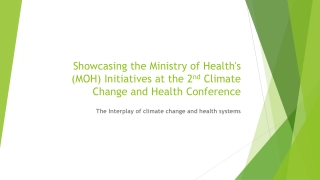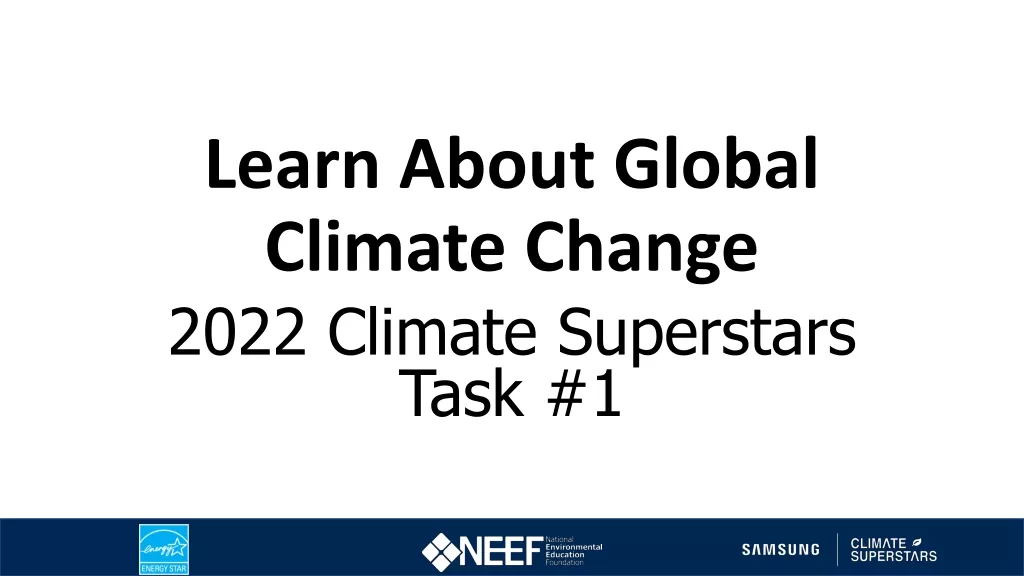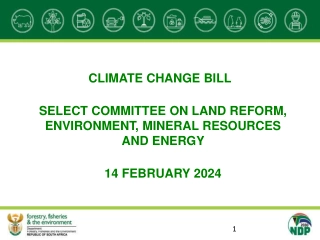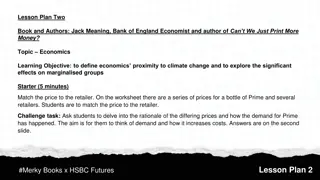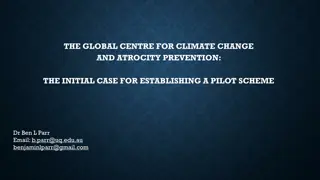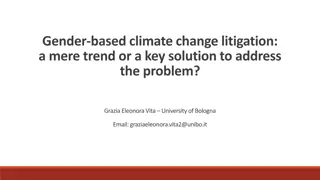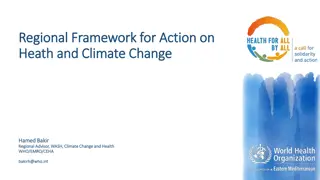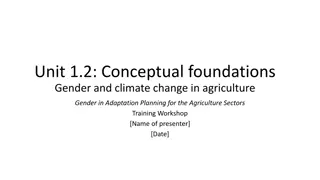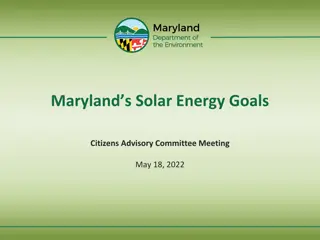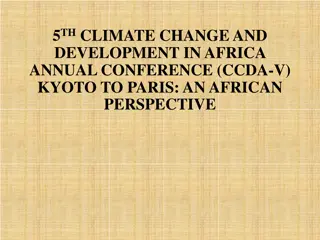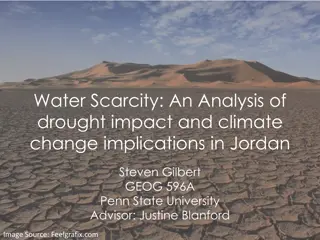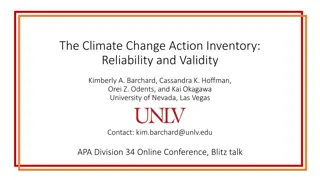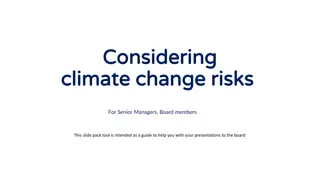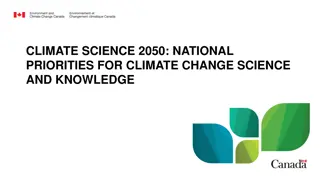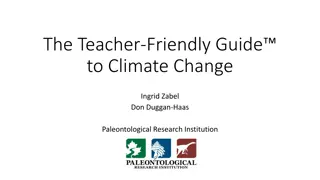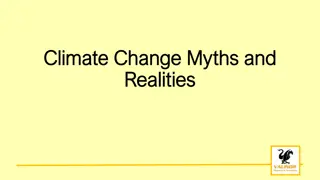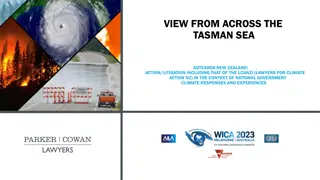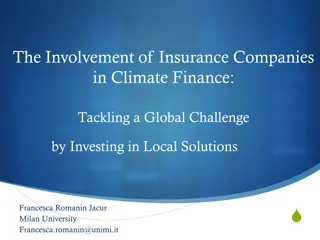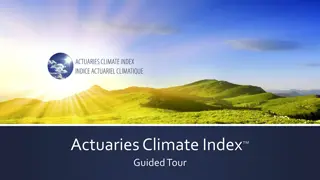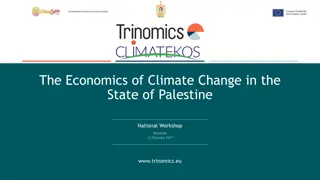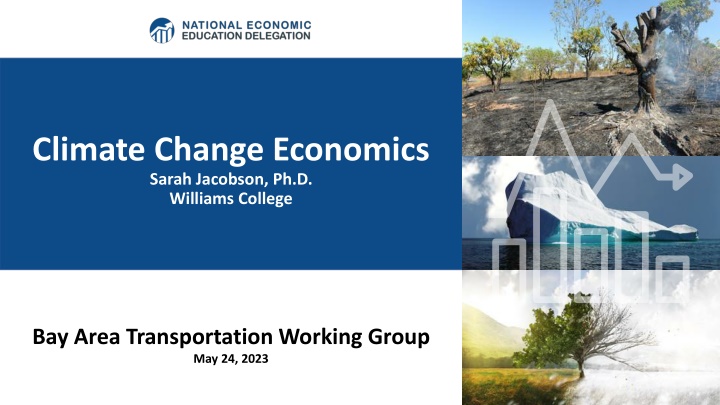
Climate Change Economics Overview
This presentation by Sarah Jacobson, Ph.D., delves into the economic aspects of climate change, discussing its impacts, emissions reduction strategies, and policy implications. Economists play a crucial role in analyzing climate change damages, estimating costs, and designing effective policies. The slides outline economic building blocks, the necessity of regulation for efficiency when decisions affect others, and the importance of cost-benefit analysis in addressing climate change.
Download Presentation

Please find below an Image/Link to download the presentation.
The content on the website is provided AS IS for your information and personal use only. It may not be sold, licensed, or shared on other websites without obtaining consent from the author. If you encounter any issues during the download, it is possible that the publisher has removed the file from their server.
You are allowed to download the files provided on this website for personal or commercial use, subject to the condition that they are used lawfully. All files are the property of their respective owners.
The content on the website is provided AS IS for your information and personal use only. It may not be sold, licensed, or shared on other websites without obtaining consent from the author.
E N D
Presentation Transcript
Climate Change Economics Sarah Jacobson, Ph.D. Williams College Bay Area Transportation Working Group May 24, 2023
Credits and Disclaimer This slide deck was authored by: - Shana McDermott, Trinity University - Sarah Jacobson, Williams College - Sharon Shewmake, Western Washington University This slide deck was reviewed by: - Jason Shogren, University of Wyoming - Walter Thurman, North Carolina State University Disclaimer - NEED presentations are designed to be nonpartisan. - It is, however, inevitable that the presenter will be asked for and will provide their own views. - Such views are those of the presenter and not necessarily those of the National Economic Education Delegation (NEED). 2
Outline Economic Building Blocks Climate Change Impacts of Climate Change Reducing Emissions Climate Change Policy Policy in Action
How Can Economists Help Fight Climate Change? By measuring climate change damages and estimating the costs of fighting climate change. By assessing behavioral reactions to climate change. By designing smart policies that minimize costs to society. 5
Econ 101: When Everything Is Simple, No Regulation Is Needed for Efficiency Simple transactions: buyer and seller feel all costs and benefits of sales They choose based on the costs & benefits they feel Efficient number of transactions! (Maximizes social benefits) 6
When Our Decisions Affect Others, We Need Regulation Pollution causes an EXTERNALITY: a side effect (here, a cost) that affects someone else - Polluting things have an unfair cost advantage because part of cost is offloaded on others - Too much pollution is generated - Regulation limiting pollution has net benefits The efficient amount of pollution balances costs & benefits of pollution
How Economists Decide How Much to Fight Climate Change: Cost Benefit Analysis Abating greenhouse gas emissions is costly but without action, climate change damages are even more costly. Expected costs of reducing emissions Expected damages from allowing climate change Goal is not zero emissions, but efficient level that achieves a balance.
Cost-Benefit Analysis of Fighting Climate Change Most economic models suggest the costs of keeping warming below 2 C are relatively small, amounting to 1-4% of GDP by 2030. Costs of acting to keep warming below 2 C are almost certainly less than future economic damages they would avoid. - Damages estimated to be between: 7-20% of worldwide GDP.
A Climate Change Ladder Emissions Mitigation (a.k.a. Abatement) Adaptation Damages 11
The Atmospheric Greenhouse Effect Sun Atmosphere Energy reflected back onto earth Energy reflected back into space
Greenhouse Gas Emissions 1990-2019 Source: IPCC
Atmospheric CO2 Concentrations Up To Now Source: NOAA
Emissions Trajectories into the Future Source: IPCC Assessment Report 5
What Do Greenhouse Gas Emissions Do to the Planet? Increased temperatures - Sea level rise - Storm surges Altered precipitation patterns More variable weather More / more powerful storms Carbon dissolves in ocean 16
These Changes Are Already Underway Use https://showyourstripes.info/ to see the temperature history of an area! Here s California!
These Changes Are Already Underway Use https://showyourstripes.info/ to see the temperature history of an area! Here s California!
How Climate Change Affects Humans Reduced fresh water availability Wildfires Shifting zones for important ecosystems, and desertification Reduced worker productivity Increased violence Some of these may cause human migration and/or conflict Agriculture Fisheries Coastal damages Direct health effects, including sickness and death (temperature & drought; also pollution) Indirect health effects (vector- borne disease)
Social Cost of Carbon The expected cost of damages from each unit of greenhouse gas emissions. Current EPA estimate: ~$51 per metric ton of CO2 - About $157/car per year for an avg driver. But in 2022 they put forward a proposal to raise it to $190! Cost will increase over time.
How Damages Will Vary Globally: Mortality as an Example 22
Adaptation Reduces Damages Adaptation: costly action that reduce damages from climate change. The net damage cost to society is the cost of adaptation plus the cost of remaining damages. People and firms will take some actions on their own, up to the point where they find it worthwhile. Some adaptation requires government involvement.
Individual-Level Adaptation Perhaps you - Stay inside more. - Turn on the air conditioning. Farmers may: - Plant at different times. - Plant new crops. Businesses may: - Give outdoor workers water / shade breaks. Everyone might: - Think about moving to a safer place.
Public Adaptation Governments can help: - When collective action is less costly than everyone acting alone. - When individual action is not possible or likely. - When some people can t protect themselves. Sea walls Ecosystems that provide protection Policies that protect workers or low-income and vulnerable populations Planned retreat (moving a community)
Global Net Emissions Are What We Care About For climate impacts, we don t care where they are emitted, only how much - There may be other local impacts Gross emissions (greenhouse gas sources): how much greenhouse gases (including CO2) we put out Greenhouse gas sinks: ways to pull CO2 out of the air - Existing: oceans, forests - Increase sinkage by planting trees, or other measures
Total US Greenhouse Gas Emissions by Economic Sector in 2021
Energy Related Emissions Are Falling (though They Still Need to Fall Further)
Which Emissions Should We Cut? List all possible ways to reduce emissions Figure out how much each can reduce in total Figure out how much each costs per unit of emissions reduced Line them up in order: cheapest to costliest ( marginal abatement cost curve ) - Tackle first the cheapest ones!
Example Abatement Cost Curve (Don t trust these numbers, this is just to show the idea)
Costs and Barriers Can Be Difficult to Assess Difficult to project future costs for new technology - Costs of renewables have been dropping fast Investments in research and development and infrastructure (e.g., EV charging) can lower future costs Barrier to expanding renewable energy: intermittency - Battery technology under development
Geoengineering and Carbon Capture Technical pathways to reduce climate change without reducing emissions Carbon capture: captures CO2 emissions and stores them or utilizes them (for energy, pressure, etc.) - Not yet proven at scale Solar geoengineering: make the atmosphere reflect more light to regain earlier thermal balance - Totally theoretical - Potentially risky
Policies That Reduce Emissions Directly Command and control regulation - Emissions standards or limits (e.g., Clean Water Act discharge limits) - Tech standards (e.g., require scrubbers on power plants) Incentive-based policies - Putting a price on emissions leveling the playing field! o Tax or cap & trade o Subsidizing green energy (e.g., feed-in tariffs) 43
Command and Control vs. Incentive-Based Regulation Efficiency - Both can achieve the same amount of emissions reduction. - Incentive-based policies can achieve emissions reduction at much lower cost. Equity - Both have may regressive impacts (low-income families bear costs that are a larger percent of their incomes vs hi-income families) o However, new evidence increasingly questions this. - Cap and trade and carbon tax can generate revenues that can be used to offset the regressivity. o E.g.: carbon dividend - Command and control regulations do not. 44
How Does a Carbon Tax Work? Choose activities to be covered (e.g., electricity sector, all emitters, etc.). Set tax level. - Optimally, it represents the social cost of polluting. Polluters must pay a tax for every unit emitted. - Polluters with low abatement costs will abate to avoid the tax - Polluters with high abatement costs will pollute and pay the tax 45
How Does Cap and Trade Work? Choose activities to be covered (e.g., electricity sector, all emitters, etc.). Set maximum emissions level ( cap ). That many pollution permits are issued. - Can be auctioned off or given to polluters Every polluter in a covered sector must have a permit for every unit of pollution. Polluters buy and sell ( trade ) permits on a market as they wish. - Polluters with low abatement costs will make / save money by abating and selling / not buying permits - Polluters with high abatement costs will buy permits and pollute 46
Examples of Other Policies that Reduce Emissions Research and development subsidies Renewable energy mandates (e.g., renewable portfolio standards) Energy efficiency mandates and subsidies (e.g. CAFE fuel economy standards) Grid / infrastructure improvements Public transportation Land use / zoning policies
Offsets and Net Zero Carbon offsets are assets that can be purchased that correspond (theoretically) to reductions in emissions elsewhere - Either reduction / prevention of a carbon source or generation / prevention of loss of a carbon sink - Examples: capping landfills for methane leaks; forest protection This lets global net emissions decline more than direct emissions do - Net zero emissions goal means new offsets must equal new emissions Can fit into any regulatory scheme to count against direct emissions (if the regulation allows them) Concerns: verifiability, additionality, ethics / justice
Leakage and Regulatory Interconnections If some areas are more tightly regulated than others, polluters may move from the high-regulation to the low-regulation areas - This is called leakage - It may cause overall pollution to not decline - So far, there s little evidence that firms relocate because of enviro rules Rationale for old broad, then deep approach Climate economists have been surprised by profusion of local & regional climate regulations Now some may get stitched together deep, then broad ?
Border Carbon Adjustments To avoid leakage & stay competitive, high-regulation places can impose border carbon adjustments Tweak prices up on imports from low-regulation places to reflect correct regulated price because of embodied pollution

